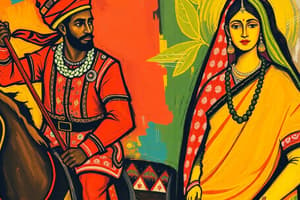Podcast
Questions and Answers
How did the portrayal of cities like Gaur in Candimangal reflect contemporary anxieties?
How did the portrayal of cities like Gaur in Candimangal reflect contemporary anxieties?
Gaur was portrayed as a site of corruption and moral decay, reflecting anxieties about foreign rule and economic exploitation.
What features of oral storytelling were retained in Mangal Kavya texts, despite being written literature?
What features of oral storytelling were retained in Mangal Kavya texts, despite being written literature?
Many texts retained features of oral storytelling through performance during religious festivals, accompanied by music, visual storytelling (such as scroll paintings), and dramatic enactments.
Explain the significance of intertextuality in Mangal Kavya, and provide examples of texts that were frequently referenced.
Explain the significance of intertextuality in Mangal Kavya, and provide examples of texts that were frequently referenced.
Intertextuality allowed authors to engage in implicit critiques or reinterpretations of existing narratives. Authors frequently referenced Sanskrit epics like the Ramayana and Mahabharata, Puranic stories, and even earlier Mangal Kavya texts.
In what ways does Mangal Kavya represent an intersection of religious, social, and political thought?
In what ways does Mangal Kavya represent an intersection of religious, social, and political thought?
How did the performance aspect of Mangal Kavya, including music and visual storytelling, enhance its cultural impact during religious festivals?
How did the performance aspect of Mangal Kavya, including music and visual storytelling, enhance its cultural impact during religious festivals?
According to Sheldon Pollock, how does Mangal Kavya differ from Sanskrit kavya in terms of political and religious discourse?
According to Sheldon Pollock, how does Mangal Kavya differ from Sanskrit kavya in terms of political and religious discourse?
According to Dipesh Chakrabarty and Kumkun Chatterjee, how did Mangal Kavya reflect Bengal's political and cultural landscape during the Mughal period?
According to Dipesh Chakrabarty and Kumkun Chatterjee, how did Mangal Kavya reflect Bengal's political and cultural landscape during the Mughal period?
Explain Ronald Inden's view on how Mangal Kavya challenges centralized political authority.
Explain Ronald Inden's view on how Mangal Kavya challenges centralized political authority.
According to France Bhattacharya and Mandakranta Bose, in what way does the portrayal of women in Mangal Kavyas reinforce patriarchal norms?
According to France Bhattacharya and Mandakranta Bose, in what way does the portrayal of women in Mangal Kavyas reinforce patriarchal norms?
How does David Curley suggest Mangal Kavya enables innovative political thought?
How does David Curley suggest Mangal Kavya enables innovative political thought?
In what ways did Mangal Kavya function beyond religious literature, and what societal issues did it address?
In what ways did Mangal Kavya function beyond religious literature, and what societal issues did it address?
How does Mangal Kavya approach the topic of Muslim rulers and their governance?
How does Mangal Kavya approach the topic of Muslim rulers and their governance?
What is meant by the term vernacularization in the context of Mangal Kavyas?
What is meant by the term vernacularization in the context of Mangal Kavyas?
How did the composition of Mangal Kavya reflect the socio-political environment of Bengal during its emergence?
How did the composition of Mangal Kavya reflect the socio-political environment of Bengal during its emergence?
In what ways did Mangal Kavya differ from traditional Sanskrit kavya in its approach to politics and audience engagement?
In what ways did Mangal Kavya differ from traditional Sanskrit kavya in its approach to politics and audience engagement?
Explain how the symbolism of forests and settlements is used in Mangal Kavya to depict societal tensions.
Explain how the symbolism of forests and settlements is used in Mangal Kavya to depict societal tensions.
How do Mangal Kavyas reflect the social hierarchy and mobility of lower-caste individuals and women, and what limitations do they face?
How do Mangal Kavyas reflect the social hierarchy and mobility of lower-caste individuals and women, and what limitations do they face?
What are the key themes explored in Dharmamangal, and how does it relate to imperial rule and warrior culture?
What are the key themes explored in Dharmamangal, and how does it relate to imperial rule and warrior culture?
How does Candimangal represent localities and transitions between different states, such as hunting, war, and peace?
How does Candimangal represent localities and transitions between different states, such as hunting, war, and peace?
In Manasamangal, what central conflict is depicted, and what consequences arise from defying divine authority?
In Manasamangal, what central conflict is depicted, and what consequences arise from defying divine authority?
How does the portrayal of political power and governance in Mangal Kavya serve as a subtle critique, and what types of conflicts are typically depicted?
How does the portrayal of political power and governance in Mangal Kavya serve as a subtle critique, and what types of conflicts are typically depicted?
Flashcards
Gaur in Candimangal
Gaur in Candimangal
A city depicted as corrupt in Candimangal, reflecting anxieties about foreign rule and economic exploitation.
Mangal Kavya Verse
Mangal Kavya Verse
A mix of simple and complex verse forms, primarily payar (rhymed couplets).
Oral Traditions in Mangal Kavya
Oral Traditions in Mangal Kavya
Despite being written, Mangal Kavya texts retained features of oral storytelling, performed with music and visual aids.
Intertextuality in Mangal Kavya
Intertextuality in Mangal Kavya
Signup and view all the flashcards
Significance of Mangal Kavya
Significance of Mangal Kavya
Signup and view all the flashcards
Historiographical Approaches
Historiographical Approaches
Signup and view all the flashcards
Vernacularization in Mangal Kavyas
Vernacularization in Mangal Kavyas
Signup and view all the flashcards
Regional Identity Formation
Regional Identity Formation
Signup and view all the flashcards
Fragmented Sovereignty
Fragmented Sovereignty
Signup and view all the flashcards
Gender Dynamics
Gender Dynamics
Signup and view all the flashcards
Political Thought
Political Thought
Signup and view all the flashcards
Socio-Political Commentary
Socio-Political Commentary
Signup and view all the flashcards
Subtle Critique
Subtle Critique
Signup and view all the flashcards
Mangal Kavya
Mangal Kavya
Signup and view all the flashcards
Characteristics of Mangal Kavya
Characteristics of Mangal Kavya
Signup and view all the flashcards
Divine justice and human agency
Divine justice and human agency
Signup and view all the flashcards
Symbolism of forests and settlements
Symbolism of forests and settlements
Signup and view all the flashcards
Social mobility and hierarchy
Social mobility and hierarchy
Signup and view all the flashcards
Political power and governance
Political power and governance
Signup and view all the flashcards
Manasamangal
Manasamangal
Signup and view all the flashcards
Candimangal
Candimangal
Signup and view all the flashcards
Study Notes
- Mangal Kavya is a genre of long, didactic, literary narrative poems from Bengal, composed from the late 15th to the 18th century.
- These texts aimed to promote the worship of deities and address socio-political issues through allegorical storytelling.
- Mangal Kavya's composition occurred in a period of agrarian expansion and changing political landscapes under Muslim rule.
- Scholars debate the literary, historical, and political implications, making it a significant subject in South Asian literary traditions.
Historical Context and Themes
- The origins of Mangal Kavya trace back to shifting political power in Bengal, where local rulers, Mughal taxation policies, and regional conflicts influenced narratives.
- Mangal Kavya was composed in vernacular Bangla, differing from Sanskrit literary traditions.
- Unlike Sanskrit kavya, Mangal Kavya focused on divine and human agency from below and incorporated oral traditions and local folklore.
- Central themes:
- Divine justice and human agency: Deities intervene in human affairs, correcting moral and social imbalances.
- Symbolism of forests and settlements: Contrasting wilderness with civilization, showing tensions between untamed nature and structured society.
- Social mobility and hierarchy: Addressing the struggles of lower-caste individuals and women within a rigid societal framework.
- Political power and governance: Subtle critique of governance through conflicts between rulers and common people.
Subgenres and Notable Texts
- Mangal Kavya is categorized into subgenres based on the deity being worshipped:
- Manasamangal: Advocates the worship of Manasa, the goddess of snakes, emphasizing consequences of defying divine authority.
- Candimangal: Focuses on the goddess Chandi, representing localities and transitions between hunting, war, and peace.
- Dharmamangal: Centers around Dharma, a formless god, and explores themes of righteousness, warrior culture, and imperial rule.
Historiographical Perspectives
- The study of Mangal Kavya is shaped by various historiographical approaches, reflecting debates in South Asian history and literature.
- Sheldon Pollock: Argues Mangal Kavya is a break from the Sanskrit literary tradition, emphasizing vernacularization of political and religious discourse.
- Dipesh Chakrabarty and Kumkum Chatterjee: Analyze Mangal Kavya in the context of regional identity formation, reflecting Bengal's unique political and cultural landscape during the Mughal period.
- Ronald Inden: Explores the genre's depiction of fragmented sovereignty, challenging centralized political authority.
- France Bhattacharya and Mandakranta Bose: Focus on gender dynamics, particularly roles of women like Behula in Manasamangal, reinforcing patriarchal norms while offering agency to female characters.
- David L. Curley: Posits Mangal Kavya serves as a medium for developing innovative political thought, critiquing contemporary governance through dialogue between divine intervention and human agency.
Socio-Political Implications
- Mangal Kavya was not just religious literature but also socio-political commentary.
- Texts addressed governance, taxation, and the relationship between rulers and subjects.
- Agrarian frontier settings reflected real-world struggles of peasants and newly settled communities in Bengal.
- Representation of Muslim rulers is nuanced, subtly depicting limitations of contemporary governance.
- The city of Gaur appears as a site of corruption and moral decay in Candimangal, reflecting anxieties about foreign rule and economic exploitation.
Literary Techniques and Oral Traditions
- Mangal Kavya was composed in simple and complex verse forms, primarily payar (rhymed couplets).
- Many texts retained features of oral storytelling, performed during religious festivals with music, visual storytelling (scroll paintings), and dramatic enactments.
- Another feature is its intertextuality, referencing Sanskrit epics like the Ramayana and Mahabharata, Puranic stories, and earlier Mangal Kavya texts.
- Intertextuality allowed for implicit critiques or reinterpretations of existing narratives.
Conclusion
- Mangal Kavya is a intersection of religious devotion, social critique, and political thought.
- Scholars have interpreted it through frameworks, including vernacularization, gender, and subaltern studies.
- By incorporating diverse voices and addressing contemporary anxieties, the texts for understanding the historical and literary landscape of Bengal from the 15th to the 18th century.
Studying That Suits You
Use AI to generate personalized quizzes and flashcards to suit your learning preferences.
Related Documents
Description
Explore Mangal Kavya, a genre of didactic poems from Bengal (15th-18th century), crafted to promote deity worship and address socio-political issues through allegorical narratives. Set against a backdrop of agrarian expansion and shifting political landscapes, these texts offer insights into Bengal's historical and literary traditions. They focus on themes like divine justice.



